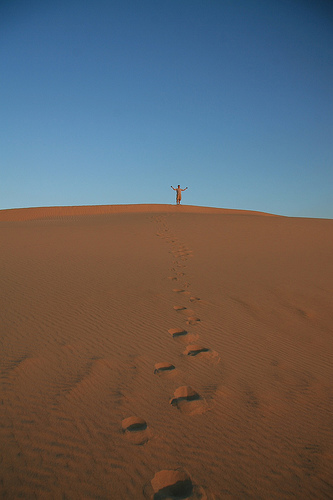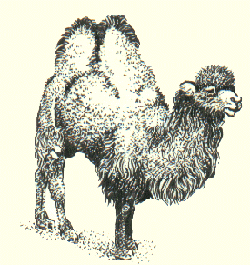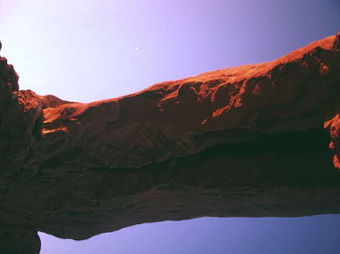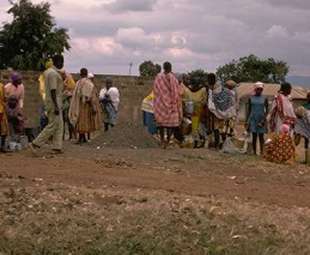Factsheet
Desert Regions
When you hear the word 'desert', what picture does it bring to mind? Perhaps you think of a very dry place, a place without people or plants living there. In fact, a deserted place.
What is a Desert?
 When you hear the word 'desert', what picture does it bring to mind? Perhaps you think of a very dry place, a place without people or plants living there. In fact, a deserted place. Perhaps you also think of miles and miles of sand dunes, and a scorching sun burning down from a cloudless sky.
When you hear the word 'desert', what picture does it bring to mind? Perhaps you think of a very dry place, a place without people or plants living there. In fact, a deserted place. Perhaps you also think of miles and miles of sand dunes, and a scorching sun burning down from a cloudless sky.
One fifth of the world's land surface is desert. A desert is technically defined as an area which has on average less than 250mm of rain per year. However, annual rainfall could be as low as 20mm, leading to periods of intense dryness which often last for several years followed by periods of heavy rainfall and flooding. Surprisingly, more people die in deserts each year from drowning than from thirst.
One of the most famous deserts, the Sahara in North Africa, is very hot and very dry. The Sahara is one of the hottest place on Earth, with a maximum recorded temperature of 58 C in the shade. Yet at night the desert becomes very cold, with temperatures often falling below freezing.
The Danakil Depression in Ethiopia holds the record for the highest average annual temperatures. 35C (95F) is the average temperature for the whole year here! There is no shade, just the unremitting heat of the sun. The picture here is of Algodones Dunes, a desert area in California, America.
Some deserts in Asia such as the Gobi desert are very cold for most of the year. Reports from a weather station at Ulaanbaatar in the middle of the Gobi desert show that for more than six months of the year, the temperature does not rise above freezing whilst during the winter months temperature regularly drops to below - 20C. Rainfall here is on average 194mm per year.
 There are four types of desert landscape. The first, and our most common vision of what a desert should look like, is the sand desert or erg. About one third of all desert landscapes are like this. The sand is blown into hills or dunes by the wind. These shift over time so that if the movements of the dunes of a sand desert over several years were filmed and then speeded up so that the film lasted only a few minutes, the movements of the desert would look like ripples in the water. It is for this reason that ergs are sometimes called "sand seas".
There are four types of desert landscape. The first, and our most common vision of what a desert should look like, is the sand desert or erg. About one third of all desert landscapes are like this. The sand is blown into hills or dunes by the wind. These shift over time so that if the movements of the dunes of a sand desert over several years were filmed and then speeded up so that the film lasted only a few minutes, the movements of the desert would look like ripples in the water. It is for this reason that ergs are sometimes called "sand seas".
The dunes may shift only very slowly, but they will over long periods of time bury anything in their path, including houses, villages or crops. For this reason, if people wish to grow any crops in deserts, the dunes have to be "fixed" in place. This is done by planting grasses with very long roots which reach deep into the sand and help to hold the dunes together, preventing the wind from blowing them away.
Find out about the other desert landscapes...
Plant and Animal Life in the Desert
A second kind of desert is the stone desert or reg. Regs are vast areas of plain covered rocks and boulders. Nothing can grow there, and the environment is extremely hostile to plant and animal life.
The third desert landscape is of high bare mountains. All soil has been eroded away, leaving just bare rock.
Finally there is the hamada. This type of desert consists of roughly level areas of bare rock. Sand has been swept away by the wind, leaving just the bare rock underneath. Such areas are completely exposed to the sun, making it impossible for anything to grow there.
All of the types of desert landscape are very vulnerable to erosion by the wind. This is because there are very few plants in deserts to bind the soil together. Sand is easily blown by the wind. When the rains do come, the water rushes over rocky areas of desert without soaking in. This adds still further to the process of erosion.
 Outside of the oases, only a few special kinds of plant are able to survive in arid deserts. There are some plants, however, that have adapted to the almost waterless conditions of the desert. These plants are called xerophytes. Xerophytes tend to have small, waxy leaves, which help the plant to retain water. Some, such as cacti, can store water in their trunks. Cacti can be up to 20 metres tall and store more than 5 tonnes of water in their bodies. Many plants have very deep root systems, which can reach up to 15 metres into the soil. Xerophytes also grow very slowly. However, when the rains do come, many desert plants grow new leaves and cacti produce colourful flowers for a few days after the rain.
Outside of the oases, only a few special kinds of plant are able to survive in arid deserts. There are some plants, however, that have adapted to the almost waterless conditions of the desert. These plants are called xerophytes. Xerophytes tend to have small, waxy leaves, which help the plant to retain water. Some, such as cacti, can store water in their trunks. Cacti can be up to 20 metres tall and store more than 5 tonnes of water in their bodies. Many plants have very deep root systems, which can reach up to 15 metres into the soil. Xerophytes also grow very slowly. However, when the rains do come, many desert plants grow new leaves and cacti produce colourful flowers for a few days after the rain.
Rain in the desert also brings to life the ephemeral plants. Their seeds can lie dormant in the soil for up to 20 years. Rainwater causes them to germinate very quickly so that the desert may be carpeted in different varieties of flowers and grasses for between six and eight weeks, after which the flowers die and the desert returns to bare, dry ground until the next rainfall.
Desert dwelling animals also have to be able to cope with extremes of temperature and with chronic water shortage. This has called for a number of adaptations. Birds are active in the cool of the morning and evening and many animals are burrowers, because burrowing allows them to escape from the heat. Other animals come out only at night. Desert animals have had to become very specialized in order to survive. Because of this specialization a desert can appear to be lifeless to the untrained eye.
Impressive Desert Solar Power
 It is believed that in just six hours, the world's deserts receive more energy from the sun than humans consume in a year. Take an area the size of Wales in the Sahara desert and fill it with solar panels and you could power the whole of Europe!
It is believed that in just six hours, the world's deserts receive more energy from the sun than humans consume in a year. Take an area the size of Wales in the Sahara desert and fill it with solar panels and you could power the whole of Europe!
The move to clean renewable energy is a very important when fighting climate change. By using natural sources such as the sun, wind and tides we can create energy without creating so much pollution. At the moment we use a lot of oil, gas and coal to power our country, but there are several large North African solar projects underway working to harness the awesome power of the desert sun!
The Sahara is the largest hot desert on earth (some deserts are cold like the Gobi desert in Asia) and can reach temperatures of 50°C. Using solar photovoltaic panels with such an abundance of sunshine will produce three times more power than a PV solar panel in the UK. By the year 2050 these projects hope to generate 15% of Europe's energy through solar and wind power. There are a few problems to solve first such as how to stop sand causing damage to the solar panels. Cleaning them daily uses up a lot of water - something that isn't common in the desert! But if technology can solve some of these problems then we will be doing a big favour to the world. Who knew the desert could be green?
Deserts and the Effects of Humans
There is evidence that deserts have existed for million of years on this planet. They do, however, seem to shift and change quickly in terms of geological time. Six and a half million years ago, the Mediterranean Sea was a desert. It had a series of salty lakes and was dotted with isolated volcanoes, which today have formed islands such as Corsica and Sardinia. Around 5.3 million years ago, the Atlantic Ocean flooded through the Straits of Gibraltar and flooded the Mediterranean, leaving it as we know it today.
Many ancient civilizations once flourished around the coast and on the islands of the Mediterranean, yet now many of these lands are deserts. Why are these lands now deserts, and why are we able to create, in a matter of a few years, deserts that take nature years to form? The story is a complicated one and begins with civilisation. Civilisation has always been about exploiting the Earth's resources to produce a better standard of living. One example of this exploitation is the Cedar of Lebanon. In biblical times, huge forests of these trees were found in Lebanon. The trees were felled and traded for grain and oil.
During the first four centuries AD, the Romans ruled much of North Africa, which supplied most of the grain for the Empire. Then the crops began to fail as the fragile soils were overploughed and overcultivated. Trees had been cleared to provide more land for cultivation, yet these trees were vital for regulating the amount of water in the soil, and also prevented soils from being blown or washed away. The soils which were washed away by the rain ended up as silt in the sea. The Romans were unable to stop the silt from filling their harbours, so within a few years their bustling, prosperous trading ports became ghost towns, with the sea moving ever further away as the continued deposition of silt led to the constant retreat of the sea. Ephesus, once a great port on the coast of Turkey is now three miles inland.
Today, the same things are happening, but as we have become more civilised, we have become much better at creating deserts. Around a quarter of the South American rainforest has already been cut or burned down in order to make land available for cultivation. The rainforest soils are very fragile though, and need the trees to hold them together. Once they are removed, the soil can be washed away very quickly. Moreover, rainforest soils are not very fertile. Within a few years of use, all the nutrients in the soil are used up, meaning that crops can no longer be grown.
The soil is little better for keeping cattle. Forest soil produces 22 kilos of beef per hectare, as opposed to 270 kilos of beef on a European farm. The long term effects of deforestation are being ignored by governments, farmers and corporations looking to make a profit out of the first few years of land use. What makes this destruction even more pointless is the fact that a properly managed area of Brazilian rainforest can produce ten times more food than land that has been claimed for use as a cattle ranch.

The Sahel, a huge strip of land along the southern edge of the Sahara desert is gradually becoming hotter and drier. The Sahel has suffered greatly from human overexploitation.
Trees have been cleared the land has been grazed, overcultivated and because of improved healthcare it is now overpopulated. With the steady decline in annual rainfall people who were previously able to prosper in this area are now in danger of starvation.
What can be Done?
There are no quick solutions to the problems. Deserts can be reclaimed but first water supplies must be established. Then trees need to be planted to regulate the supply of water in the soil and to "fix" it in place. The free grazing of animals has to be stopped. For nomadic peoples, this can mean settling down on a piece of land and giving up their previous existence. Trees and water have to be carefully used and people need education on how to get the best from their land without overexploitation.
All of the above have to be done if an area of desert is to be turned into valuable agricultural land. Such measures would cost a staggering amount of money in the Sahel alone. For now, the West seems content to view the problems in Africa as tragic, but distant. We provide food aid but there is not enough to go round. What is needed is land reclamation and proper training for the people who are to farm the land. This would mean providing water and training for fifty million people.
If every family in Britain spent £1 less each week on its food and gave this money instead to famine relief, think of the work that could be done to save areas of land from becoming deserts. Imagine what could be done if this idea were taken up by the rest of the western world!
Clearly something has to be done. Natural deserts can be very beautiful, despite their hostile climate. We are creating deserts for ourselves now at a faster rate than Nature can. If action is not taken soon the consequences could be disastrous for us all.
School Project Ideas
- Imagine that your class is going on an expedition into the Sahara Desert. What means of transport would you use? What kind of clothing would you need? How much food and water would you have to take with you? Think about the ways in which you would have to adapt to be able to survive for a month in a desert.
- You could also plan a similar expedition to a cold desert, such as the Gobi Desert. What change would you need to make to your supplies and equipment?
- Find out more about animals and plants which live in the desert. How are they adapted to live in intense heat, or in the case of animals and plants living in cold deserts, how are they adapted to loving in sub-zero temperatures during winter and the heat of the summer? How do they survive with very little water?
To find out more about deserts see the Related Resources below - visit our factsheet Desertification and our free downloadable magazine all about Deserts.
Credits
Image: Desert Regions by Abdullah Almaosharji
Information sourced from:
Desert (2000) [online], Available from: http://www.blueplanetbiomes.org/desert.htm [accessed 01/06/2015].
The Earth Story (2014), Dallol, Ethiopia [online], Available from: http://the-earth-story.com/post/76123432503/dallol-ethiopia-dallol-is-found-in-the-danakil [accessed 01/06/2015].
Nature Flip (2015), Gobi Desert [online], Available from: http://www.natureflip.com/gobi-desert [accessed 01/06/2015]
New Internationalist Magazine (2015), Desertec: the renewable energy grab? [online], Available from: http://newint.org/features/2015/03/01/desertec-long/ [accessed 01/06/2015]
 When you hear the word 'desert', what picture does it bring to mind? Perhaps you think of a very dry place, a place without people or plants living there. In fact, a deserted place. Perhaps you also think of miles and miles of sand dunes, and a scorching sun burning down from a cloudless sky.
When you hear the word 'desert', what picture does it bring to mind? Perhaps you think of a very dry place, a place without people or plants living there. In fact, a deserted place. Perhaps you also think of miles and miles of sand dunes, and a scorching sun burning down from a cloudless sky. There are four types of desert landscape. The first, and our most common vision of what a desert should look like, is the sand desert or erg. About one third of all desert landscapes are like this. The sand is blown into hills or dunes by the wind. These shift over time so that if the movements of the dunes of a sand desert over several years were filmed and then speeded up so that the film lasted only a few minutes, the movements of the desert would look like ripples in the water. It is for this reason that ergs are sometimes called "sand seas".
There are four types of desert landscape. The first, and our most common vision of what a desert should look like, is the sand desert or erg. About one third of all desert landscapes are like this. The sand is blown into hills or dunes by the wind. These shift over time so that if the movements of the dunes of a sand desert over several years were filmed and then speeded up so that the film lasted only a few minutes, the movements of the desert would look like ripples in the water. It is for this reason that ergs are sometimes called "sand seas".
 Outside of the oases, only a few special kinds of plant are able to survive in arid deserts. There are some plants, however, that have adapted to the almost waterless conditions of the desert. These plants are called xerophytes. Xerophytes tend to have small, waxy leaves, which help the plant to retain water. Some, such as cacti, can store water in their trunks. Cacti can be up to 20 metres tall and store more than 5 tonnes of water in their bodies. Many plants have very deep root systems, which can reach up to 15 metres into the soil. Xerophytes also grow very slowly. However, when the rains do come, many desert plants grow new leaves and cacti produce colourful flowers for a few days after the rain.
Outside of the oases, only a few special kinds of plant are able to survive in arid deserts. There are some plants, however, that have adapted to the almost waterless conditions of the desert. These plants are called xerophytes. Xerophytes tend to have small, waxy leaves, which help the plant to retain water. Some, such as cacti, can store water in their trunks. Cacti can be up to 20 metres tall and store more than 5 tonnes of water in their bodies. Many plants have very deep root systems, which can reach up to 15 metres into the soil. Xerophytes also grow very slowly. However, when the rains do come, many desert plants grow new leaves and cacti produce colourful flowers for a few days after the rain. It is believed that in just six hours, the world's deserts receive more energy from the sun than humans consume in a year. Take an area the size of Wales in the Sahara desert and fill it with solar panels and you could power the whole of Europe!
It is believed that in just six hours, the world's deserts receive more energy from the sun than humans consume in a year. Take an area the size of Wales in the Sahara desert and fill it with solar panels and you could power the whole of Europe!
